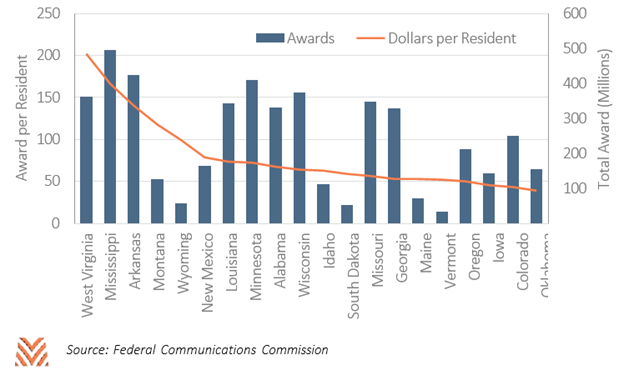The Rural Digital Opportunity Fund

In 2017, the federally appointed Interagency Task Force on Agriculture and Rural Prosperity released a report detailing their top priorities to foster rural growth. They found that access to robust internet service was critical for workforce development, implementation of new technologies, and capital access. In the wake of this report, the Federal Communications Commission (FCC) has issued several rounds of funding designed to foster rural broadband access. In October, the FCC announced a list of 386 approved applicants for its Rural Digital Opportunity Fund (RDOF) Phase I Auction. This program will allocate up to $20.4 billion to areas that do not offer what the FCC considers to be high-speed internet.
This program represents a large expansion over prior federal efforts. The USDA’s ReConnect program has awarded $642 million to date, while the FCC’s Connect America Fund has awarded $1.5 billion. The FCC’s eligible areas for the RDOF program cover almost 4 million homes, mostly in communities that have lagged national economic growth. In counties that have the largest share of homes eligible for RDOF, county-level GDP growth averaged 1.9% in 2018. In counties with the smallest share, growth was 2.5% percent over the same period.
While there are some familiar names in the list of RDOF awardees, the recipient list is broad. Just 22 applicants represent more than 90% of the initial award of $9.2 billion, but many of those applicants represent large consortiums. Nearly 200 cooperative entities are represented by these consortiums, with interests across much of the country. Other awardees range from traditional large corporations, like CenturyLink, to newer entrants, like Space Exploration Technologies Corp. (SpaceX).
The size of this program means that almost every county in the U.S. will likely see some benefit, though there is significant regional variation. In states like West Virginia and Wyoming, the FCC has already awarded more than $100 per person through the RDOF program. Across much of the Midwest, investment on a per person basis is closer to $50, while many states in New England were awarded less than $10 per resident due to their existing infrastructure.

RDOF awardees are currently in the process of securing letters of credit commitment letters and are certifying their applications. These awardees that we know now are likely those that will receive support through the program. This 10-year commitment should help both foster growth in these underserved rural communities and enable adoption of new technologies for agricultural producers. Enhanced broadband alone is not a panacea to rural America’s unique challenges, but new investments like RDOF may narrow the gap between urban and rural growth.










